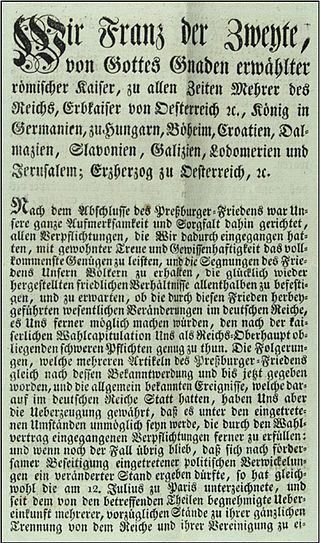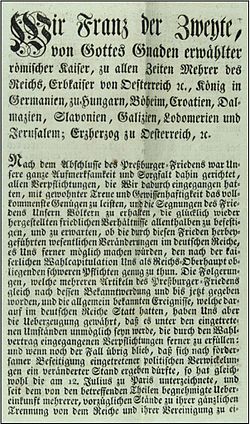神圣罗马帝国解体
来自维基百科,自由的百科全书
神圣罗马帝国解体(英语:Dissolution of the Holy Roman Empire),指的是一个发生在1806年8月6日,最后一位神圣罗马皇帝哈布斯堡-洛林家族的弗朗茨二世公开宣布放弃其皇帝头衔,允许帝国内的全部德意志邦国独立,并让帝国臣民、官员、贵族的义务、责任、爵位和誓言即刻作废的历史事件。
自欧洲中世纪以来,神圣罗马帝国因其皇帝被教皇册封为“罗马人的国王”而被西欧人认定为古罗马帝国的合法延续以及拉丁基督教界的世俗领袖。通过这一罗马的遗产,神圣罗马帝国皇帝声称自己是普世君主,其管辖范围超出其帝国的正式边界,延伸至整个基督教欧洲及其他地区。神圣罗马帝国的衰落是一个持续几个世纪的漫长过程。首先始于三十年战争对德意志地区经济和人口的摧残,这场战争同时使得哈布斯堡家族的实力大大受损,帝国南北被严重割裂为相互敌视的公教和新教两派。随后是16和17世纪第一个现代主权领土国家的形成,这带来了管辖权对应于实际管辖领土的观念,威胁到神圣罗马帝国的普世性。
18世纪时的神圣罗马帝国被帝国内外的同时代人广泛认为是高度“不规则”和“病态”的君主制,具有“不寻常”的政府形式。帝国既没有中央常备军也没有中央国库,其君主是选举而非世袭的,无法行使有效的中央集权,随着时间的发展变得越发格格不入。即使在那时,大多数同时代人都相信帝国可以复兴和现代化。在18世纪末卷入法国大革命战争和拿破仑战争之后,神圣罗马帝国终于开始了真正的衰落。
尽管帝国最初防御得很好,但与法国和拿破仑的战争证明是灾难性的。1804年拿破仑宣布自己为法国人的皇帝,神圣罗马皇帝弗朗茨二世对此做出回应,宣布自己为奥地利皇帝弗朗茨一世,以此试图维持法国和奥地利之间的平等,同时也说明了神圣罗马帝国的头衔比他们都高。1805年12月奥地利在灾难性的奥斯特里茨战役中战败,第三次反法同盟以失败告终。1806年7月,弗朗茨二世的德意志附庸大量脱离,组成法国的卫星国莱茵邦联,这意味着事实上神圣罗马帝国的终结。1806年8月的退位,加上整个帝国等级制度及其机构的解散,被认为是防止拿破仑宣布自己为神圣罗马帝国皇帝的可能性所必需的,这使得弗朗茨二世最终沦为了拿破仑的附庸。
同时代的人对帝国解体的反应从冷漠到绝望不等。哈布斯堡君主国首都维也纳的民众对帝国的终结感到震惊。许多弗朗茨二世的前臣民质疑他的行为是否合法;尽管他的退位被认为是完全合法的,但帝国的解体和所有附属国的离去被视为超出了皇帝的权力。因此,许多帝国的亲王和臣民拒绝接受帝国已经消失的事实,一些平民甚至认为帝国解体的消息是地方当局的阴谋。在德意志地区,这场解体被广泛比作古代的特洛伊城陷落,一些人将他们认为是罗马帝国的终结,并与世界末日和天启联系起来。
参考资料
- Berg, Scott M. In the Shadow of Joesphinism: Austria and the Catholic Church in the Restoration, 1815-1848. Louisiana State University Master's Thesis. 2010 [2023-01-23]. (原始内容存档于2023-07-04).
- Blanning, Tim. The Holy Roman Empire of the German Nation past and present. Historical Research. 2012, 85 (227): 57–70. doi:10.1111/j.1468-2281.2011.00579.x.
- Burgdorf, Wolfgang. ‘Once we were Trojans!’ Contemporary Reactions to the Dissolution of the Holy Roman Empire of the German Nation. Evans, Robert; Wilson, Peter H. (编). The Holy Roman Empire, 1495-1806: A European Perspective. Brill. 2012. ISBN 978-90-04-20683-0.
- Bryce, Viscount James Bryce. The Holy Roman Empire. Good Press. 2019 [1864]. ASIN B081TFMGRC.
- Chaloupek, Günther. The Congress of Vienna and the Emerging Rivalry between Austria and Prussia for Hegemony in Central Europe. Contribution to the 28th Heilbronn Symposion in Economics and the Social Sciences. 2015 [2023-01-23]. (原始内容存档于2023-01-27).
- Correspondence Respecting the Affairs of Italy: 1846–1847. Harrison and Son. 1847.
- Datta, Pietro Luigi. Lezioni di paleografia e di critica diplomatica sui documenti della monarchia de Savoia. Coi tipi di G. Pomba. 1834.
- Davies, Norman. Vanished Kingdoms: The Rise and Fall of States and Nations. Penguin. 2012. ISBN 9780143122951.
- Flockerzie, Lawrence J. Saxony, Austria, and the German Question after the Congress of Vienna, 1815-1816. The International History Review. 1990, 12 (4): 661–687. JSTOR 40106275. doi:10.1080/07075332.1990.9640563.
- Gagliardo, John G. Reich and Nation: The Holy Roman Empire as Idea and Reality, 1763–1806. Indiana University Press. 1980. ISBN 978-0253167736.
- Godsey, William D. Nobles and Nation in Central Europe: Free Imperial Knights in the Age of Revolution, 1750–1850. Cambridge: Cambridge University Press. 2004.
- Harrison, Henrietta. The Qianlong Emperor's Letter to George III and the Early-Twentieth-Century Origins of Ideas about Traditional China's Foreign Relations. The American Historical Review. 2017, 122 (3): 680–701 [2023-01-23]. doi:10.1093/ahr/122.3.680. (原始内容存档于2022-12-28).
- Lentz, Thierry. Napoleon and Charlemagne. Napoleonica. La Revue. 2008, 1: 45–68 [2023-01-23]. doi:10.3917/napo.081.0002. (原始内容存档于2017-06-30).
- Morris Jr., Warren B. The Prussian Plan of Union: Traditional Policy by "Revolutionary" Means. The Historian. 1977, 39 (3): 515–530. doi:10.1111/j.1540-6563.1977.tb01200.x.
- Muldoon, James. Empire and Order: The Concept of Empire, 800–1800. Springer. 1999. ISBN 978-1-349-39644-3. doi:10.1057/9780230512238.
- Orford, Anne. Jurisdiction Without Territory: From the Holy Roman Empire to the Responsibility to Protect. Michigan Journal of International Law. 2009, 30 (3): 981–1015 [2023-01-23]. (原始内容存档于2022-12-05).
- Renna, Thomas. Papal Approval of Holy Roman Emperors, 1250–1356. Expositions. 2017, 11 (2): 57–90 [2023-01-23]. (原始内容存档于2022-12-28).
- Watson, Alexander. Ring of Steel: Germany and Austria-Hungary in World War I. Basic Books. 2014. ISBN 978-0465018727.
- Whaley, Joachim. Germany and the Holy Roman Empire, Volume II: The Peace of Westphalia to the Dissolution of the Reich, 1648–1806. Oxford: Oxford University Press. 2012.
- Wilson, Peter H. Bolstering the Prestige of the Habsburgs: The End of the Holy Roman Empire in 1806. The International History Review. 2006, 28 (4): 709–736. S2CID 154316830. doi:10.1080/07075332.2006.9641109.
- Wilson, Peter H. The Meaning of Empire in Central Europe around 1800. Forrest, Alan; Wilson, Peter H. (编). The Bee and the Eagle: Napoleonic France and the End of the Holy Roman Empire, 1806. Palgrave Macmillan. 2009. ISBN 978-0-230-00893-9.
- Wilson, Peter H. Heart of Europe: A History of the Holy Roman Empire. Cambridge, MA: Belknap Press. 2016.
Wikiwand - on
Seamless Wikipedia browsing. On steroids.

